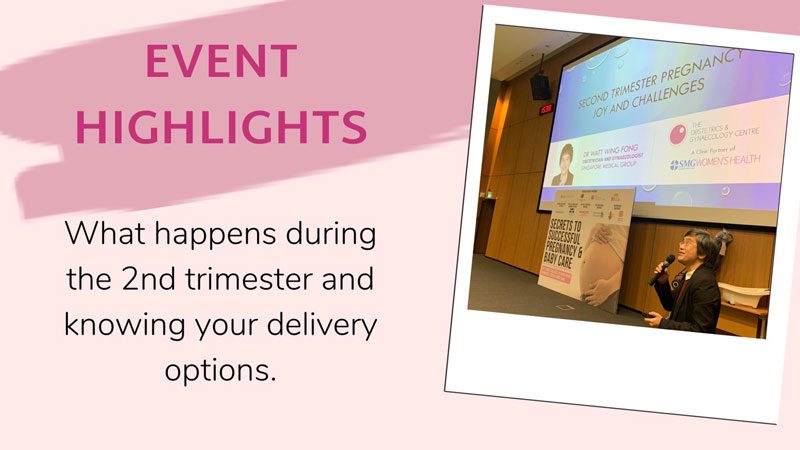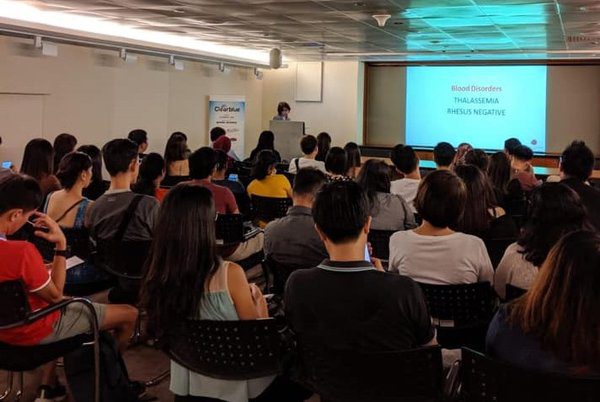
On 26 October, we joined SuperMom, Singapore’s largest parenting community to share more with new parents on some secrets to a successful pregnancy and babycare.
Dr Watt from The Obstetrics and Gynaecology Centre shared more about the 2nd Trimester, understanding your scans and planning your delivery/labour options available.
Tips on what happens during the second trimester
For many mummies, going into the second trimester often brings a sigh of relief and is the most enjoyable stage during pregnancy. The pregnancy typically becomes more stable as the hormonal levels fluctuate less. Depending on the advice of the obstetrician, some couples also take this time to go overseas before welcoming their little ones.
What to expect during the second trimester:
- Hormones start to balance
- Morning sickness starts to cease
- Tiredness and tenderness in the breast usually eases
- Appetite increases & weight gain
- More prominent baby bump
- Skin stretches, causing stretch marks and some itchiness
- Pigmentation on the belly and on the face
- Inflamed gums
- Constipation as the womb starts to grow
- Milk discharge from nipples as the breast prepares for breastfeeding
- Increased nasal congestion and nose bleeds
Screening of chromosomal abnormalities & diagnostic tests during the second trimester
During the second trimester, obstetricians will perform multiple scans and test to ensure that the baby is doing well. They will perform the following:
- Screening for chromosomal abnormalities
- Diagnostics tests
- Pre-eclampsia screening
- Ultrasound scans for fetal anomaly.
During 11-14 weeks, obstetricians will screen for chromosomal abnormalities. These chromosomal abnormalities include Down syndrome (T21), Edwards Syndrome (T18) and Patou’s syndrome (T13). Screening for these abnormalities are first done through a Nuchal Translucency Scan, followed by a either an OSCAR test or Non-invasive Prenatal Test (NIPT), depending on the recommendation of the doctor. Read more about antenatal tests here.
Dr Watt thoroughly highlights that screening for chromosomal abnormalities can be inaccurate at times and that mums should consult their obstetricians on exploring further diagnostic tests.
Pre-eclampsia screening
Pre-eclampsia affects a large number of women and babies, and can be serious if untreated. It is a disorder that is related to high blood pressure and is often screened during 11-13 weeks. Early detection through screening tests can also help to significantly reduce the incidence of pre-eclampsia.
Ultrasound scans
As ultrasound scans are part of every mother’s routine checkup with their obstetricians, it is also a way to detect possible defects such as:
- Neural tube defects
- Chromosomal abnormalities
- Congenital heart defects
- Gastrointestinal & kidney defects
- Cleft lip or palate
- Birth Defects of the limbs
Upon diagnosis, obstetricians will recommend options such as counselling, further tests, termination of pregnancy or involve a paediatrician (for after birth).
For those who are in their 3rd trimester and preparing for delivery, know your options.
For those who are in their third trimester and preparing for delivery, Dr Watt shared more about the types of deliveries, Pros and Cons of each method and what to expect in labour.
Types of delivery methods that Dr Watt shared about includes:
- Natural birth
- Assisted vaginal birth (Either forceps or Ventouse)
- Caesarean section (C-section)
Delivery Method |
Pros |
Cons |
|---|---|---|
Natural Birth |
|
|
Assisted vaginal birth (Either forceps or Ventouse) Usually performed when the baby needs to be delivered quickly and within the right conditions |
|
|
Caesarean section (C-section) Two types: Elective – planned C-section Emergency – unplanned C-section |
|
|
Delivery Method |
Pros |
Cons |
|---|---|---|
Natural Birth |
|
|
Assisted vaginal birth (Either forceps or Ventouse) Usually performed when the baby needs to be delivered quickly and within the right conditions |
|
|
Caesarean section (C-section) Two types: Elective – planned C-section Emergency – unplanned C-section |
|
|
With the different types of delivery methods, Dr Watt highly advise those who have uncomplicated pregnancies to go with vaginal delivery. However, for mummies with a preference for C-sections, obstetricians will respect your wishes. In special circumstances such as maternal conditions (i.e. pre-eclampsia) and fetal distress,vaginal delivery might not be suitable and should not be attempted.
Dr Watt also highlights that mummies should also monitor their due dates and work with their doctors as it might impact their method of delivery.
This is brought to you by our SMG WH editorial team.



